Across the varied landscapes of Ohio, from the serene shores of Lake Erie to the rolling hills of the Appalachian Plateau, a striking array of hawks commands the skies. These majestic raptors, known for their sharp eyes and powerful flight, offer an enchanting spectacle for birdwatchers and nature enthusiasts alike.
Whether you’re an experienced birder or a beginner, the journey of exploring Ohio’s birds of prey and hawks promises a rich and rewarding experience.
Types of Hawk in Ohio
Red-tailed Hawks: One of the most widespread species, they can frequently be spotted soaring above Ohio’s open country, particularly in the agricultural areas surrounding the city of Lima.
Red-shouldered Hawks: These are commonly sighted in the wooded wetlands of the Cuyahoga Valley National Park in Northeast Ohio.
Cooper’s Hawks: Found throughout the state, their dense woodland habitat makes them a common sighting in areas like Mohican State Forest.
Broad-winged Hawks: Often seen during migration season in the vast expanse of the Wayne National Forest located in Southeastern Ohio.
Sharp-shinned Hawks: Known to frequent mature forests, a good place to spot them is in the Hocking Hills region.
Northern Harrier: Their distinctive low flying hunting style can be observed in the marshy areas of the Ottawa National Wildlife Refuge, located along the Lake Erie coastline.
Rough-legged Hawks: Winter visitors to Ohio, they can be seen in open fields and meadows, particularly in the rural areas of Western Ohio.
Northern Goshawks: This secretive bird is a rare sight but has been spotted in the dense forests of the Shawnee State Park in Southern Ohio.
Osprey: These fish-eating hawks have made a comeback and can now be found nesting near large bodies of water such as the Hoover Reservoir in Westerville.
Ohio Hawks Photo Guide
Red-tailed Hawk (Buteo jamaicensis)

The Red-tailed Hawk is a large bird of prey that is commonly found across North America. This species is part of the genus Buteo, which is often referred to as the “true hawks,” and includes more than two dozen species of raptors.
Red-tailed Hawks have a robust size, ranging from 18 to 26 inches in length and sporting a wingspan that can exceed 4 feet. They have a broad, rounded set of wings and a short, wide red tail. This species is most easily recognized by its rich, rust-colored tail, which gives it its common name. However, juvenile hawks might not yet have this distinctive feature.
Their feathers are generally dark brown on their dorsal side (back) with a lighter, often speckled, ventral side (front). The intensity and pattern of their plumage can vary significantly based on their age and geographic location, as there are about 14 recognized subspecies of Red-tailed Hawks.
As for their diet, Red-tailed Hawks are carnivores and have a broad diet that includes rodents, ground rabbits, reptiles, and other birds. They are skilled hunters that typically sit on high perches and use their keen eyesight to spot potential prey. Once they have identified a target, they swoop down to capture it with their powerful talons.
Red-tailed Hawks mate for life and build nests high off the ground, often in tall trees or on cliff edges. Their nests are made of sticks and can be quite large. They typically lay 1-3 eggs per year, which are incubated by both parents.
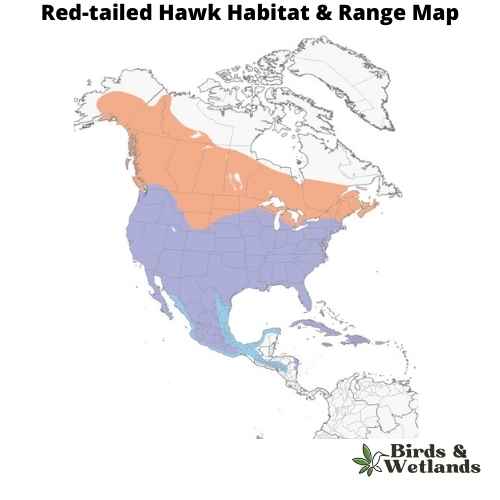
Red-tailed Hawk Sound
Red-shouldered Hawk (Buteo lineatus)

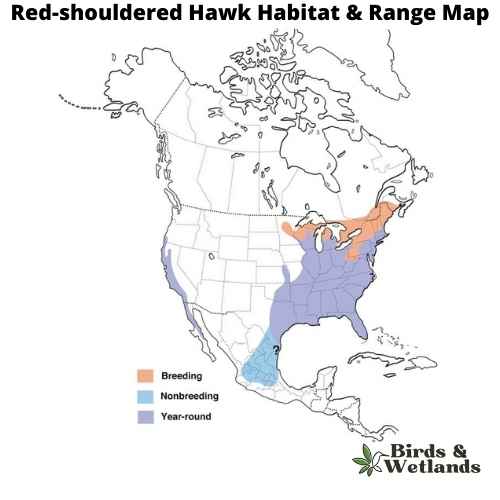
Listen:
The red-shouldered hawk are medium sized birds of prey, part of the buteo hawks family. It can be distinguished from other hawks by its reddish iris and pale legs.
The adult has rusty red upperparts, white underparts, a black chin and throat, and a reddish brown stripe over each eye, reddish brown heads and a strongly banded tail. The tail is reddish brown with two paler bands across it and they have white checkered wings. Juveniles are brown with dark barring and have pale fringes on the feathers of their wings.
Red-shouldered hawks nest in trees, though they also inhabit manmade structures including barns, bridges, and buildings. They prefer wooded areas with an open canopy but will use other places as well for nesting such as shrubs and hedges if needed.
The red-shouldered hawk’s diet – they eat small mammals such as ground squirrels, rabbits, voles, mice and rats. They also eat birds such as quail, pigeons and doves; reptiles including snakes; amphibians; fish; crustaceans; insects; and carrion (dead animals).
Cooper’s Hawk (Accipiter cooperii)

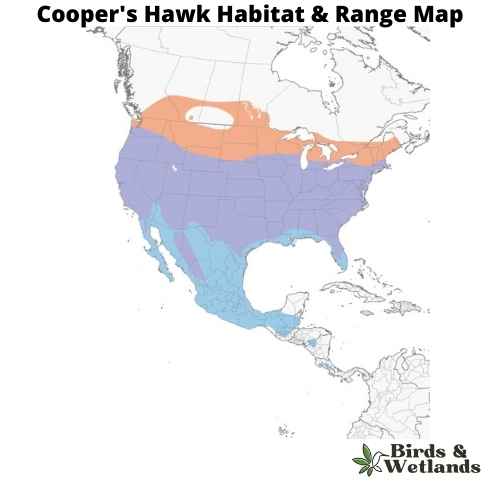
Listen:
The Cooper’s Hawk is a medium-sized bird of prey native to North America. Known for its agility and speed, it is part of the Accipitridae hawk species, which also includes other hawks, eagles, and kites.
Cooper’s Hawks are typically about 14 to 20 inches in length, with a wingspan ranging from 27 to 36 inches. They are known for their distinctive long, rounded tails and short, rounded wings. They have a steely blue gray top, with rusty bars on their underparts and thick, dark bands on their tails.
The Cooper’s Hawk is a skilled predator, primarily hunting birds and small mammals. They are adept at hunting in both dense forests and open areas, often catching prey mid-air in high-speed pursuits. They have also been known to visit the backyard bird feeder, not for the seed, but to prey on the smaller birds that gather there.
Cooper’s Hawks often build nests in dense tree canopies where they are well concealed. The female usually lays 3 to 5 eggs, and both parents share incubation duties. The young hawks fledge after about a month but will stay close to the nest, relying on their parents for food as they learn to hunt.
Broad-winged Hawk (Buteo platypterus)

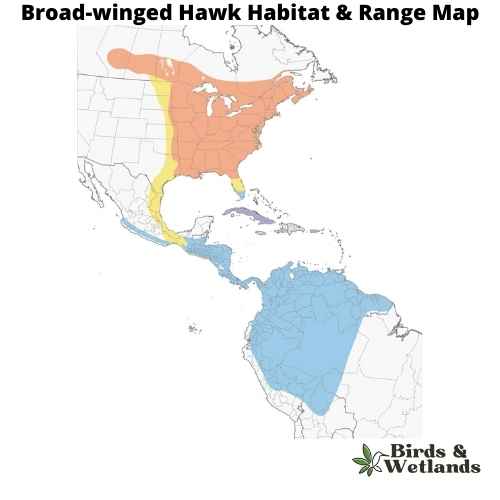
Broad-winged Hawk Sound
The Broad-winged Hawk holds a commanding presence as one of the largest hawks in the world, known for its broad wings. Its formidable size is a testament to its prowess as a bird of prey, effortlessly navigating the open skies in search of food.
Their distinctive appearance sets them apart. The adults exhibit a striking black and white pattern, complemented by a rusty breast and buff underparts and brown wings. In contrast, juveniles are adorned with a brown plumage, marked by pale edges on their feathers, adding to their distinctive youthful charm.
These hawks are most commonly found in open areas, such as farmlands or grasslands interspersed with scattered trees, which provide optimal conditions for when hawks hunt.
When it comes to their diet, Broad-winged Hawks feed on small rodents like mice, rats, squirrels, rabbits, and voles. Broad winged hawks breed during the spring and summer months then migrate to central and south America.
Sharp-shinned Hawk (Accipiter striatus)

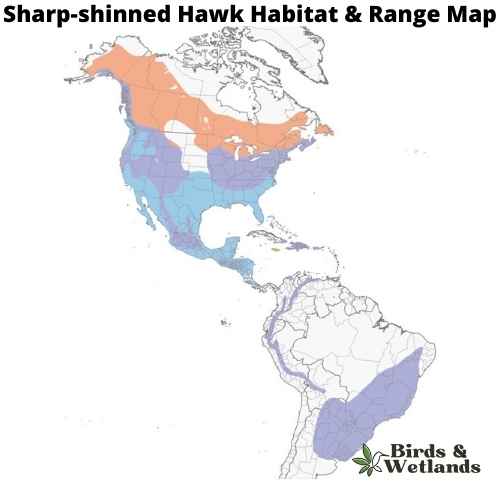
Listen:
The adult bird is brown on top and white underneath, with a dark brown band across its chest. It has short, rounded wings and a long tail that makes it look larger than it actually is. Adult sharp shinned hawks have black eyes, which are surrounded by white feathers. The female Sharp-shinned Hawk is browner than the male, who has darker brown markings on his back.
Sharp-shinned Hawks prefer open country for their habitat, including fields and meadows where they can hunt for mice and other small animals. They can be found throughout the United States but are most common in the east.
Sharp-shinned Hawks eat mostly small birds, such as sparrows and warblers, as well as small mammals such as mice and gophers. They catch prey by surprise using their incredible speed and agility, diving out of the sky at speeds up to 200 mph.
Sharp-shinned Hawks have an unusual hunting style for hawks—they prefer to catch their prey from perches above trees or telephone wires, rather than swooping down from above like most other hawks do and can often be seen hunting near bird feeders.
Northern Harrier (Circus hudsonius)

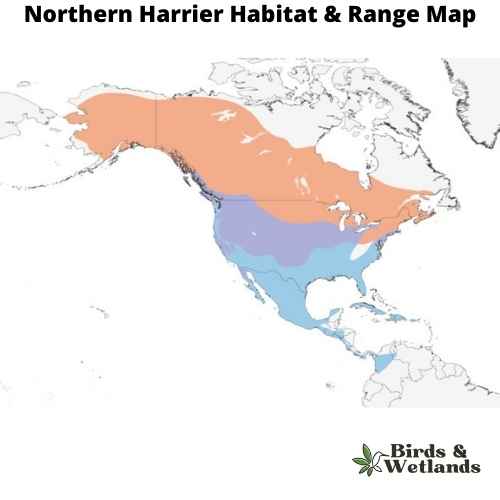
Listen:
The Northern Harrier is a medium-sized, slender hawk.
Adult birds are gray above, with pale bars on the wing feathers and white markings on the underwings and a white rump patch. The breast is barred with black and white, and the belly is streaked with brown.
They prefer open areas, such as grasslands and marshes, but can be found in almost any open habitat except dense woods.
Northern Harriers are opportunistic hunters that feed on small mammals such as mice, voles and rabbits as well as birds including quail, grouse and ducks. They hunt by flying low over open spaces such as fields or marshes.
Northern harrier nests on the ground in lowlands or hillsides near water bodies. It lays two to four eggs which hatch after 24 days of incubation by both parents. The chicks fledge after 30 days of hatching and remain dependent on their parents for another three weeks during which they learn how to fly.
Rough-legged Hawk (Buteo lagopus)

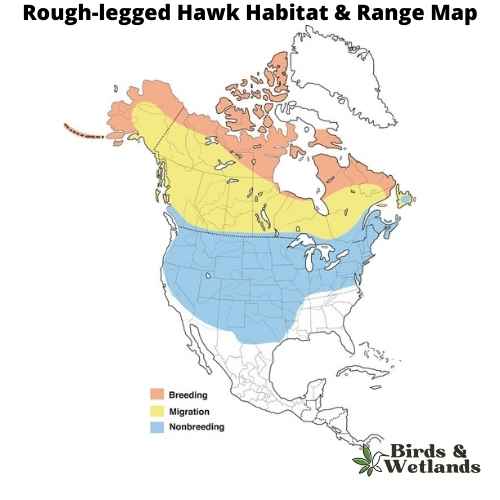
Rough-legged Hawk Sound
The Rough-legged Hawk is a large, raptor that is native to North America. It is also known as the American Rough-legged Hawk. Scientific Name: Buteo lagopus
The Rough-legged Hawk is a medium-sized hawk with a distinctive appearance, with dark brown feathers on its back and light brown feathers on its underside and broad thin wings. The hawk’s legs are also covered in dark feathers, which help to distinguish it from other species of hawk. The tail is barred with black and white. They have yellow eyes and dark feet.
Rough-legged Hawks hunt from above ground level, swooping down to catch its prey in its talons. When hunting for food, they prefer to eat small mammals such as squirrels and rabbits but will also eat birds if there aren’t any small mammals available. Although they eat a variety of small animals including birds, rodents, bats and reptiles, they rely heavily on fish for food during breeding season because it provides them with protein and calcium needed to produce eggs.
Northern Goshawk (Accipiter gentilis)


Listen:
The Northern Goshawk is a medium-sized hawk that is found in North America, Europe and Asia. It has brown eyes, a large sharp beak, and dark brown plumage on its upperparts and head, with white underparts that are spotted with brown barring. Its tail feathers are grayish-black with a dark band near the tip.
Northern goshawks eat squirrels, rabbits, grouse, woodchucks and other small mammals like voles or mice (which they often eat whole). They will also take larger prey such as deer fawns or even adult deer if they have no other choice. They have broad wings with long feathers that allow them to glide through the air when they catch their prey. They also have an excellent sense of smell which helps them locate their food source.
The Northern Goshawk builds its nest in a tree cavity or on a ledge, usually on the edge of an open area so it can easily see prey below. The female lays 3 to 5 eggs over two days and incubates them for 28 to 30 days while the male brings food to her every few hours until they hatch. The young fledge after about 6 weeks and leave the nest when they are about 10 weeks old.
Osprey (Pandion haliaetus)

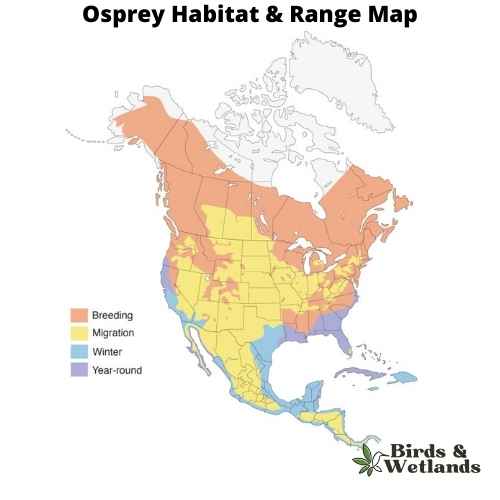
Osprey Sound
Scientific Name: Pandion haliaetus
Length: 50–66 cm (19+1⁄2–26 in)
Wingspan: 127–180 cm (50–71 in)
Weight: 0.9–2.1 kg (2 lb 0 oz – 4 lb 10 oz)
The Osprey, a fascinating bird of prey, is universally known for its exceptional hunting prowess and striking physical characteristics. Osprey are dark brown hawks on the upperparts, contrasting beautifully with the predominantly white underparts, and a distinctive dark band that stretches across the eyes towards the sides of its head.
Equipped with specialized talons and a reversible outer toe, the Osprey’s hunting strategy involves a spectacular plunge-dive into bodies of water, often emerging with a fish securely gripped in its claws.
Found on every continent except Antarctica, the Osprey is a cosmopolitan species favoring habitats near water bodies such as lakes, rivers, and coastal areas, reflecting its piscivorous diet. This bird has a diet almost exclusively of fish, making it a unique member of the raptor family and often referred to as the sea hawk or fish hawk. They locate their prey from the air, often hovering before plunging feet-first to capture a fish. When it comes to breeding, Ospreys are monogamous, often mating for life.
They construct large, bulky nests made of sticks, lined with softer materials, and prefer elevated or isolated areas such as treetops or artificial structures like utility poles. Both parents share the responsibility of incubating the eggs and rearing the chicks.
Where to Spot Hawks in Ohio
Lake Erie Birding Trail: Comprising 84 individual sites, this trail is a migratory pathway for many hawk species. Magee Marsh Wildlife Area, a part of this trail, is an excellent location to watch Broad-winged Hawks and Northern Harriers during migration seasons.
Hocking Hills State Park: Located in Southeastern Ohio, this park with its varied terrain is a good location to spot Red-shouldered Hawks and Cooper’s Hawks.
Cuyahoga Valley National Park: This national park, situated between Akron and Cleveland, is known for its rich biodiversity and is a preferred habitat for several species of hawks including the Red-tailed Hawk and Sharp-shinned Hawk.
Shawnee State Park: This park is located in the Appalachian foothills and its dense forests and ample water bodies attract a variety of hawks, including the Northern Goshawk.
| Neighbouring State’s Hawks | Hawk Watching Site |
|---|---|
| Hawk Species in Michigan | Detroit River Hawk Watch |
| Hawk Species in Indiana | Eagle Creek Park |
| Hawk Species in Kentucky | Bernheim Arboretum and Research Forest |
| Hawk Species in West Virginia | Hanging Rock Raptor Observatory |
| Hawk Species in Pennsylvania | Hawk Mountain Sanctuary |

